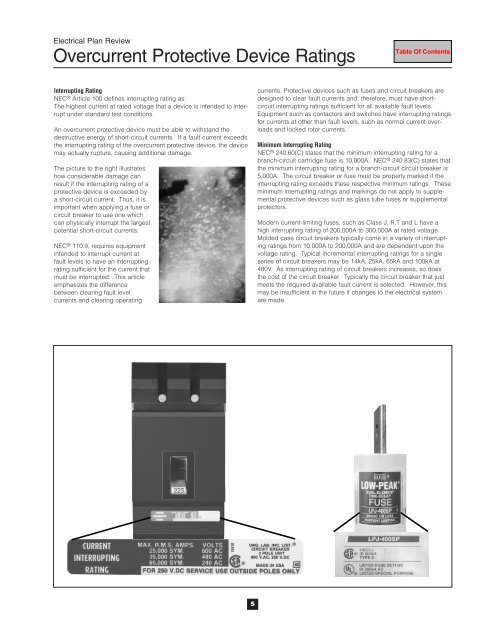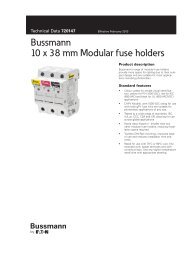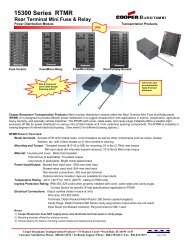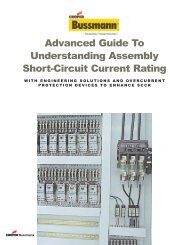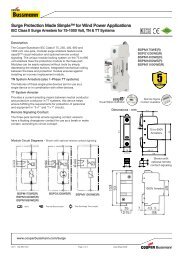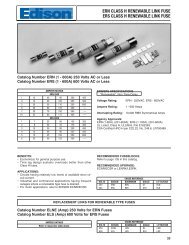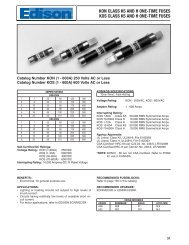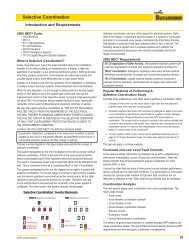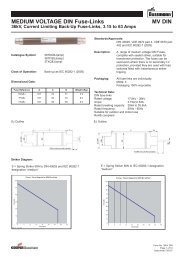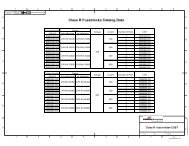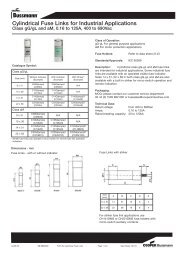Overcurrent Protection and Devices, Short-Circuit Calculations ...
Overcurrent Protection and Devices, Short-Circuit Calculations ...
Overcurrent Protection and Devices, Short-Circuit Calculations ...
Create successful ePaper yourself
Turn your PDF publications into a flip-book with our unique Google optimized e-Paper software.
Electrical Plan Review<br />
<strong>Overcurrent</strong> Protective Device Ratings<br />
Interrupting Rating<br />
NEC ® Article 100 defines interrupting rating as:<br />
The highest current at rated voltage that a device is intended to interrupt<br />
under st<strong>and</strong>ard test conditions.<br />
An overcurrent protective device must be able to withst<strong>and</strong> the<br />
destructive energy of short-circuit currents. If a fault current exceeds<br />
the interrupting rating of the overcurrent protective device, the device<br />
may actually rupture, causing additional damage.<br />
The picture to the right illustrates<br />
how considerable damage can<br />
result if the interrupting rating of a<br />
protective device is exceeded by<br />
a short-circuit current. Thus, it is<br />
important when applying a fuse or<br />
circuit breaker to use one which<br />
can physically interrupt the largest<br />
potential short-circuit currents.<br />
NEC ® 110.9, requires equipment<br />
intended to interrupt current at<br />
fault levels to have an interrupting<br />
rating sufficient for the current that<br />
must be interrupted. This article<br />
emphasizes the difference<br />
between clearing fault level<br />
currents <strong>and</strong> clearing operating<br />
currents. Protective devices such as fuses <strong>and</strong> circuit breakers are<br />
designed to clear fault currents <strong>and</strong>, therefore, must have shortcircuit<br />
interrupting ratings sufficient for all available fault levels.<br />
Equipment such as contactors <strong>and</strong> switches have interrupting ratings<br />
for currents at other than fault levels, such as normal current overloads<br />
<strong>and</strong> locked rotor currents.<br />
Minimum Interrupting Rating<br />
NEC ® 240.60(C) states that the minimum interrupting rating for a<br />
branch-circuit cartridge fuse is 10,000A. NEC ® 240.83(C) states that<br />
the minimum interrupting rating for a branch-circuit circuit breaker is<br />
5,000A. The circuit breaker or fuse must be properly marked if the<br />
interrupting rating exceeds these respective minimum ratings. These<br />
minimum interrupting ratings <strong>and</strong> markings do not apply to supplemental<br />
protective devices such as glass tube fuses or supplemental<br />
protectors.<br />
Modern current-limiting fuses, such as Class J, R,T <strong>and</strong> L have a<br />
high interrupting rating of 200,000A to 300,000A at rated voltage.<br />
Molded case circuit breakers typically come in a variety of interrupting<br />
ratings from 10,000A to 200,000A <strong>and</strong> are dependent upon the<br />
voltage rating. Typical incremental interrupting ratings for a single<br />
series of circuit breakers may be 14kA, 25kA, 65kA <strong>and</strong> 100kA at<br />
480V. As interrupting rating of circuit breakers increases, so does<br />
the cost of the circuit breaker. Typically the circuit breaker that just<br />
meets the required available fault current is selected. However, this<br />
may be insufficient in the future if changes to the electrical system<br />
are made.<br />
5


